skip to main |
skip to sidebar

YOU GUISE. Seriously, you guys. SRSLY. I LOVE strawberries. Like, I would marry them if I could. They're perfection. And it's STRAWBERRY SEASON OMG.
Now, my mom made one of the best cakes I've ever had for my birthday and do you know what I did? I left my camera at home. And it was GORGEOUS. She made this Almond Chiffon Cake with mixed berries beautifully piled on top (it looked just like that pic) and it was DELISH. I'm really disappointed that I forgot my camera but it was a crazy-awesome birthday and I got caught up.
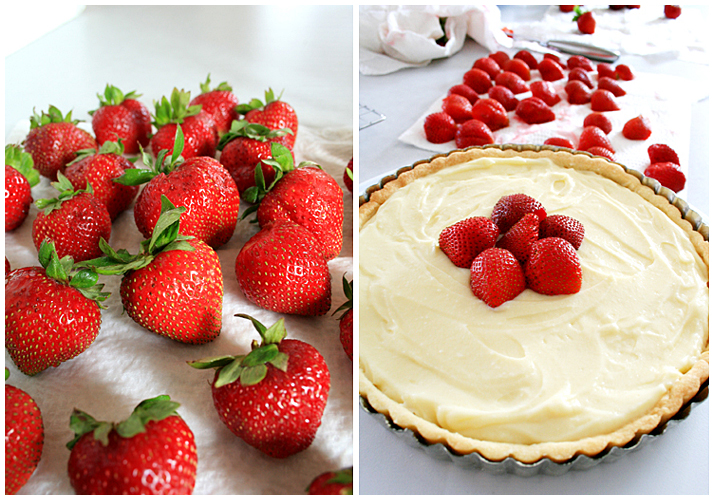
To continue on the OMG FRESH BERRIES kick, I picked up some strawberries this weekend and got right to using them! The first is this strawberry tart which, okay, tarts? They are TIME CONSUMING. You prepare the ingredients by laying some out to come to room temp (or freezing butter for the dough), then you assemble the dough and put that back in the freezer once it's in the pan. Make the pastry cream (which I'm getting better at with practice) then throw that in the fridge for a couple more hours. You bake the tart crust and set that out to cool. Once that's cool and then the cream is properly chilled, you can finally prep the strawberries and assemble everything! It took most of Saturday.
But it was TOTALLY worth it. I love fruit tarts. It was a hit with the family too! Success all around! I should make more tarts...
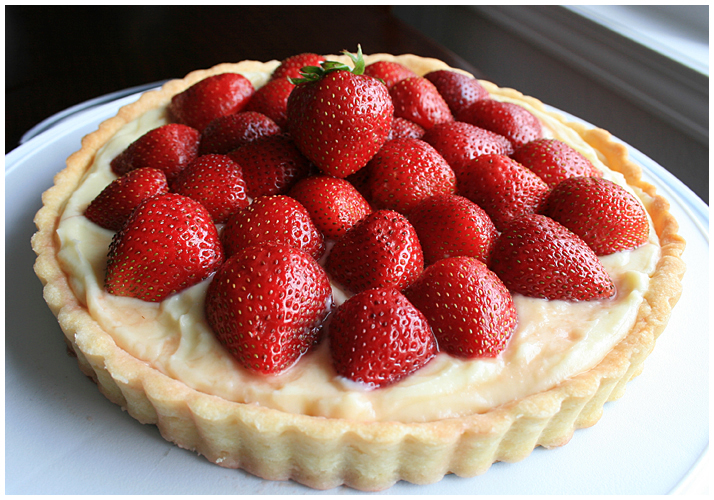
STRAWBERRY TART
SWEET TART DOUGH
Dorie Greenspan's Baking: From My Home To Yours
1 1/2 cups all-purpose flour
1/2 cup confectioner's sugar
1/4 teaspoon salt
1 stick plus 1 tablespoon (9 tablespoons; 4 1/2 ounces) very cold (or frozen) unsalted butter, cut into small pieces
1 large egg yolk
1. Put the flour, sugar and salt in the bowl of a food processor and pulse a few times to combine. Scatter the pieces of butter over the dry ingredients and pulse until the butter is coarsely cut in—you should have pieces the size of oatmeal flakes and some the size of peas. Stir the yolk, just to break it up, and add it a little at a time, pulsing after each addition. When the egg is in, process in long pulses—about 10 seconds each—until the dough, which will look granular soon after the egg is added, forms clumps and curds. If dough does not come together, add 1-2 Tbsp of cold water, 1 Tbsp at a time, until you can pinch dough together.
Turn the dough out onto a work surface and, very lightly and sparingly, knead the dough just to incorporate any dry ingredients that might have escaped mixing.
2. To roll or press the dough into the pan: Butter a 9-inch fluted tart pan with a removable bottom.
If you want to roll the dough, chill it for about 2 hours before rolling (unless you've used frozen butter and the dough comes out of the processor firm and cold, in which case you can roll it immediately). I find it easiest to roll this dough out between two sheets of plastic film – make sure to peel away the film frequently, so it doesn't get rolled into the dough.
If you want to use the press-in method, you can work with the dough as soon as it's processed. Just press the dough evenly over the bottom and up the sides of the pan. Don't be too heavy-handed – press the crust in so that the edges of the pieces cling to one another, but don't press so hard that the crust loses its crumbly texture.
PASTRY CREAM
Tartine
2 cups whole milk
1/2 cup + 1 tbsp sugar
2 large eggs
4 tbsp unsalted butter
1/4 tsp salt
3 tbsp cornstarch
1 tsp vanilla extract
Pour the milk into a heavy saucepan. Add the salt, place over medium-high heat, and bring to just under a boil, stirring occasionally. Meanwhile, whisk together the cornstarch and sugar. Add the eggs and whisk until smooth (don't let the eggs and sugar stand together for too long or else the sugar will cook the eggs *so I've heard*).
When the milk is ready, slowly drizzle about 1/3 of the hot milk into the egg mixture, whisking continuously. Pour the egg-milk mixture back into the hot milk and continue whisking until the custard is as thick as lightly whipped cream, about 2 minutes. The mixture must come just to the boiling point (slow bubbles, not boiling vigorously, or you will curdle the eggs, yuk). Remove from heat and immediately pour through a sieve into a bowl. Stir in the vanilla extract. Let cool for 10 minutes, stirring occasionally. Cut the butter into 1 tbsp pieces and whisk into pastry cream 1 tbsp at a time until smooth.
Cover the bowl with plastic wrap, pressing directly onto the top of the cream to prevent a skin from forming and put in the refrigerator to cool for 3 hours or up to 2 days.
Assemble tart inside pan to prevent crust breaking. Cover with desired fruit! (For a glossy coat, microwave about 1/4 cup apricot (or raspberry or strawberry) jam for 30 seconds or until liquid enough to brush over fruit.)

There's little that's more disappointing than failure. Especially when you pour time and effort into something that results in a complete waste of both. This is what happened with my first attempt at mini tarts.
My first mistake, probably, was believing I could splice a couple recipes together without having adequate knowledge of the procedure in the first place. Without specific instructions on how thick to roll the dough, I did it TOO thick. The mini crusts weren't weighed down with beans or pie weights and they came out thick, pale and barely cooked. The custard was a disaster: cooked too long and turning into a glob of rubbery goo. If ever there was a time to describe a baking attempt as a TOTAL failure, this was it.
And yet, as a perfectionist, I can't leave something done wrong. It has to be right. So, in classic cliché form (yes, I DID say to myself, "If at first you don't succeed..."), I tossed the failure in the garbage and started again with a new recipe and some determination. I'd learned a few things so maybe screwing up is necessary every now and then. I made the crust thinner, weighed it down (as the hasn't-failed-me-yet Ina instructed), baked it until I felt it was done. I was WAY more cautious with the custard, took it off the heat the moment it came together enough for me and added the last bit of butter and vanilla while still in the pan. It was so good, I was licking the spoon. And the bowl. ...and the pan a little after it cooled.
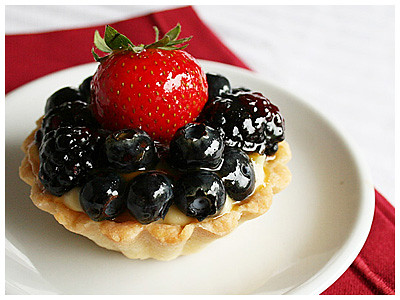
In the end, I guess my comically bad first attempt was a good learning experience because it made this success all the more satisfying. It felt much more like an accomplishment than it otherwise would have.
Oh and they taste really good. :)
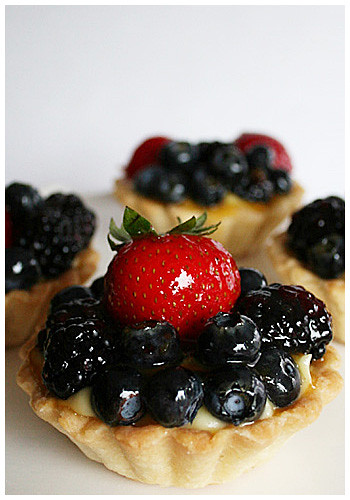
MINI BERRY TARTS
Adapted from Ina Garten
Tart Shells:
1 1/4 cups all-purpose flour
3 tablespoons sugar
1/2 teaspoon kosher salt
6 tablespoons (3/4 stick) cold unsalted butter, diced
2 tablespoons cold shortening (recommended: Crisco)
1/4 cup ice water
Pastry Cream:
5 extra-large egg yolks, room temperature
3/4 cup sugar
3 tablespoons cornstarch
1 1/2 cups scalded milk
1/2 teaspoon pure vanilla extract
1 tablespoon unsalted butter
1 tablespoon heavy cream
1–2 cups mixed berries (strawberries, blueberries, blackberries, raspberries)
1/3 cup apricot jelly
Combine the flour, sugar, and salt in a small bowl and place in the freezer for 30 minutes. Put the flour mixture in the bowl of a food processor fitted with a steel blade. Add the butter and shortening and pulse about 10 times, or until the butter is in the size of peas. Add the ice water and process until the dough comes together. Dump on a well-floured board and form into a disk. Wrap in plastic and chill for at least 30 minutes.
Meanwhile, preheat the oven to 375 degrees F.
Roll out the dough to roughly 1/4-inch thick and use round cutters (or small bowls) to cut shapes to fit into 5 (3-inch) tart pans (or your preferred size mini tins). Don't stretch the dough when placing it in the pans or it will shrink during baking. Cut off the excess by rolling the pin across the top of each pan. Line the tart shells with a piece of buttered aluminum foil, butter side down, and fill them with dried beans or rice. Bake for 10 minutes. Remove the beans and foil, prick the bottom of the shells all over with a fork, and bake for another 15 to 20 minutes until lightly browned. Set aside to cool.
In the bowl of an electric mixer fitted with the paddle attachment, beat the egg yolks and sugar on medium-high speed for 4 minutes, or until very thick. Reduce to low speed, and add the cornstarch.
With the mixer still on low, slowly pour the hot milk into the egg mixture. Pour the mixture into a medium saucepan and cook over low heat, stirring constantly with a wooden spoon, until the mixture thickens, 5 to 7 minutes. Don't be alarmed when the custard comes to a boil and appears to curdle; switch to a whisk and beat vigorously. Cook, whisking constantly, for another 2 minutes; the custard will come together and become very thick, like pudding. Stir in the vanilla, Cognac, butter, and heavy cream. Pour the custard through a sieve into a bowl. Place plastic wrap directly on the custard and refrigerate until cold.
Before serving, fill the tart shells with the pastry cream. Arrange the berries decoratively on top of the cream. Melt the apricot jelly with 1 teaspoon of water and brush the top of the tarts.
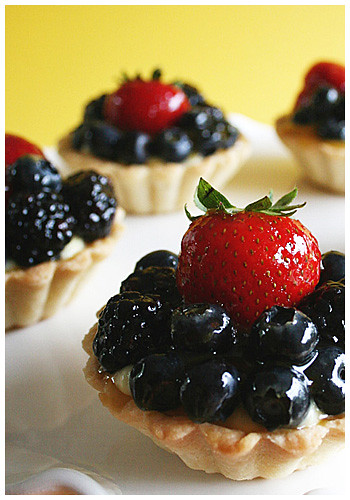
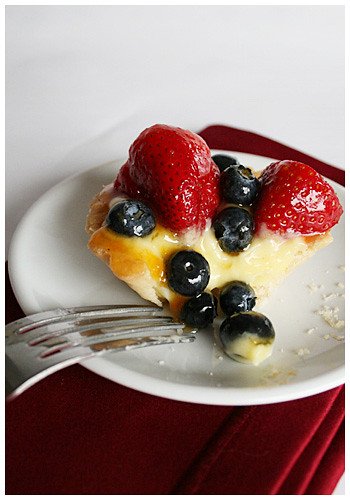
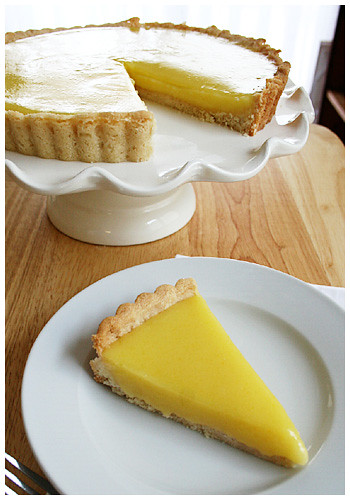 You know when something doesn't turn out exactly as you wanted so then it's this complete disappointment? To you and you alone? Yeah. I mean, I don't know what I was expecting but it wasn't this really, REALLY tart (I mean, strong?), powerful lemon tart. I mean, seriously intense. And the recipe calls for no whipped cream whatsoever so this is how it's supposed to be eaten. I would make whipped cream were I to serve it to human people.
You know when something doesn't turn out exactly as you wanted so then it's this complete disappointment? To you and you alone? Yeah. I mean, I don't know what I was expecting but it wasn't this really, REALLY tart (I mean, strong?), powerful lemon tart. I mean, seriously intense. And the recipe calls for no whipped cream whatsoever so this is how it's supposed to be eaten. I would make whipped cream were I to serve it to human people.
 As you can see from the second picture, the crust came out thicker than I expected too but I discovered that was damn near necessary to counter the strong lemon flavor. And I think I have a misconception about tart dough: it is not, in fact, PIE dough. It's supposed to be denser and not flakey and flimsy. A tart must stand on it's own; it doesn't have a pie plate to hold all those lovely, crumbly flakes of crust together. It was pretty good in the end and I enjoyed it with the lemon.
As you can see from the second picture, the crust came out thicker than I expected too but I discovered that was damn near necessary to counter the strong lemon flavor. And I think I have a misconception about tart dough: it is not, in fact, PIE dough. It's supposed to be denser and not flakey and flimsy. A tart must stand on it's own; it doesn't have a pie plate to hold all those lovely, crumbly flakes of crust together. It was pretty good in the end and I enjoyed it with the lemon.
 One thing about the curd, though, which I wish the recipe would've mentioned but didn't: when you add the lemon juice to the egg mixture, the entire thing looks awful and curdled! Even after I put it on the stove and began stirring my hand off, the stuff just looked like curdled eggs! I was sure I was ruined. And yet, I stirred and stirred until FINALLY the mix began to turn and eventually became the silky smooth consistency. So when the mix looks curdled, don't worry! It's not!
One thing about the curd, though, which I wish the recipe would've mentioned but didn't: when you add the lemon juice to the egg mixture, the entire thing looks awful and curdled! Even after I put it on the stove and began stirring my hand off, the stuff just looked like curdled eggs! I was sure I was ruined. And yet, I stirred and stirred until FINALLY the mix began to turn and eventually became the silky smooth consistency. So when the mix looks curdled, don't worry! It's not!
But seriously. Serve this with a dollop of whipped cream. Or a big glass of milk.
LEMON CURD TART
Source: Ina Garten
For the tart shell:
12 tablespoons (1 1/2 sticks) unsalted butter, plus more for greasing, at room temperature
1/2 cup sugar
1/2 teaspoon pure vanilla extract
1 3/4 cups all-purpose flour
Pinch salt
For the lemon curd:
4 lemons, at room temperature
1 1/2 cups sugar
1/4 pound (1 stick) unsalted butter, at room temperature
4 extra-large eggs, at room temperature
1/8 teaspoon salt
For the tart shell:
Mix the butter and sugar together in the bowl of an electric mixer fitted with a paddle attachment until they are just combined. Add the vanilla. In a medium bowl, sift together the flour and salt, then add them to the butter-and-sugar mixture. Mix on low speed until the dough starts to come together. Dump onto a surface dusted with flour and shape into a flat disk. Press the dough into a 10-inch-round or 9-inch-square false-bottom tart pan, making sure that the finished edge is flat. Chill until firm.
Meanwhile, preheat the oven to 350 degrees F.
Butter 1 side of a square of aluminum foil to fit inside the chilled tart and place it, buttered side down, on the pastry. Fill with beans or rice. Bake for 20 minutes. Remove the foil and beans, prick the tart all over with the tines of a fork, and bake again for 20 to 25 minutes more, or until lightly browned. Allow to cool to room temperature.
For the lemon curd:
Remove the zest of the lemons with a vegetable peeler or zester, being careful to avoid the white pith. Squeeze the lemons to make 1/2 cup of juice and set the juice aside. Put the zest in a food processor fitted with a steel blade. Add the sugar and process for 2 to 3 minutes, until the zest is very finely minced. In the bowl of an electric mixer fitted with a paddle attachment, cream the butter with the sugar and lemon zest. Add the eggs, 1 at a time, and then add the lemon juice and salt. Mix until combined.
Pour the mixture into a 2-quart saucepan and cook over low heat, stirring constantly, until thickened, about 10 minutes. The lemon curd will thicken at about 175 degrees F, or just below a simmer. Remove from the heat.
Fill the tart shell with warm lemon curd and allow to set at room temperature.

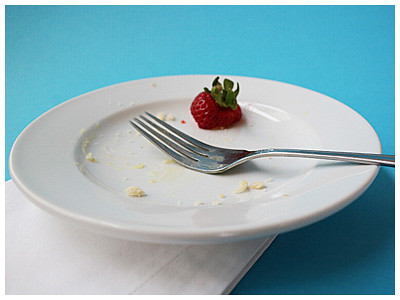
 I've been having a hard time deciding on what I was in the mood for in January, the month of new, fresh starts (read: light and healthier) but still, you know. Dead of winter. And I live in Alaska. It looks like this:
I've been having a hard time deciding on what I was in the mood for in January, the month of new, fresh starts (read: light and healthier) but still, you know. Dead of winter. And I live in Alaska. It looks like this:
 I started concocting this elaborate, perfect dessert for the season that I attempted but dare not speak its existence for fear of being smited, it was so awful. Let's just say, the syrup soaked dough balls came out looking like mini jellyfish (that wanted to eat ME).
I started concocting this elaborate, perfect dessert for the season that I attempted but dare not speak its existence for fear of being smited, it was so awful. Let's just say, the syrup soaked dough balls came out looking like mini jellyfish (that wanted to eat ME).
Luckily, I had a backup plan to ALSO try my first tart ever this weekend after I got a food processor for Christmas. I could finally make dough without the debilitating terror of having to touch it (and screw the whole thing up with my lava-fire hands that would melt the butter, then stretch it too much and omg!) It was time consuming (refrigerating the dough a couple times) but I've got a new appreciation for pans that shape stuff prettily (look at the little crinkles! They're perfect!).
It came out surprisingly good! My confidence in my tart-making abilities is through the roof. w00t!



ITALIAN ALMOND TART
Adapted from Williams-Sonoma Collection Series, Pie & Tart, by Carolyn Beth Weil
TART DOUGH
1 egg yolk
2 Tbs. very cold water
1 tsp. vanilla extract
1 1/4 cups unbleached all-purpose flour
1/3 cup sugar
1/4 tsp. salt
8 Tbs. (1 stick) cold unsalted butter, cut into
1/4-inch cubes
TART FILLING
8 Tbs. (1 stick) unsalted butter, at room
temperature
1/2 lb. almond paste, cut into 1-inch cubes
1/4 cup sugar
2 eggs
1/3 cup unbleached all-purpose flour
1/3 cup apricot jam (or raspberry, plum or cherry)
1/3 cup sliced almonds
GLAZE
1/3 cup apricot jam (or peach)
2 Tbs water
1 tsp. of Almond Extract (or 1 tablespoon Disaronno Amaretto)
In a small bowl, stir together the egg yolk, water and vanilla; set aside.
Stir together the flour, sugar and salt in the medium bowl and put in food processor. Add the butter and pulse processor until the texture resembles coarse cornmeal, with butter pieces no larger than small peas. Add the egg mixture and pulse just until the dough pulls together.
Transfer the dough to a work surface, pat into a ball and flatten into a disk. Wrap in plastic wrap and refrigerate until well chilled, about 30 minutes.
On a lightly floured board, flatten the disk with 6 to 8 gentle taps of the rolling pin. Lift the dough and give it a quarter turn. Lightly dust the top of the dough or the rolling pin with flour as needed, then roll out from center until the dough is about 1⁄8 inch thick. Fold the dough round in half and carefully transfer to a 9 1⁄2-inch tart pan, preferably with a removable bottom. Unfold and ease the round into the pan, without stretching it, and pat it firmly into the bottom and up the sides of the pan. Trim off any excess dough by gently running a rolling pin across the top of the pan. Press the dough into the sides to extend it slightly above the rim to offset any shrinkage during baking.
Refrigerate or freeze the tart shell until firm, about 30 minutes. Meanwhile, position a rack in the lower third of an oven and preheat to 375°F.
Line the pastry shell with lightly buttered aluminum foil or parchment paper and fill with pie weights or raw short-grain rice or beans. Bake for 20 minutes, then lift an edge of the foil. If the dough looks wet, continue to bake, checking every 5 minutes, until the dough is pale gold, for a total baking time of 25 to 30 minutes. Transfer to a wire rack.
Position a rack in the middle of the oven and reduce the heat to 350°F.
In a bowl, using an electric mixer on medium speed or a whisk, beat the butter until smooth. Add the almond paste, one piece at a time, beating until smooth after each addition. While continuing to beat, sprinkle in the sugar. Add the eggs one at a time, beating well after each addition. Stir in the flour.
Spread the jam evenly over the bottom of the partially baked tart shell. Spoon in the almond paste mixture and spread evenly over the jam. Sprinkle the surface evenly with the sliced almonds.
Bake the tart until the filling is golden and the middle is firm to the touch, 35 to 45 minutes.
Heat glaze preserves and water in a 1-quart saucepan over moderately high heat, stirring, until preserves are melted. Remove from heat and force through a fine-mesh sieve into a small bowl, discarding solids. Stir in almond extract.
Brush top of hot tart generously with glaze and cool in pan on rack 15 minutes. Remove side of pan and cool tart completely, about 2 hours.
Serve at room temperature. Makes one 9 1/2-inch tart; serves 8.
























